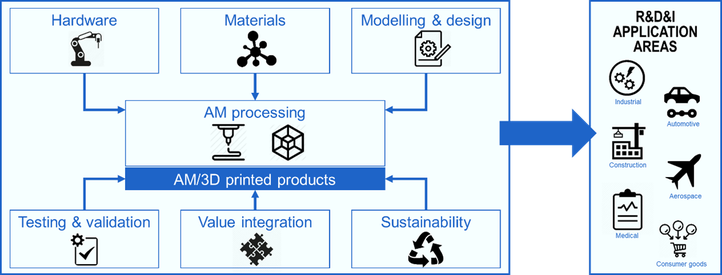Technologies
Importance of AM/3D printing technologies
Additive Manufacturing (AM), commonly known as 3D printing, is a new production technique which has been attracting a lot of attention for several decades. Moreover, it has experienced a very strong growth in the last 5 years. The global revenue growth raised from USD 5 billion in 2015 to USD 15 billion in 2020 (source: Markets and Markets) and a further forecast annual growth of 17.7% until 2025.
AM is therefore increasingly evolving from a technique that was mainly used to make non-functional prototypes into a technique to produce functional parts. The AM market is therefore very diverse and includes many facets and production techniques. This makes AM one of the main technologies of the future.
This technology in which objects are fabricated via the addition of material to create the required geometry. A 3D model is created using a computer aided design software and then uploaded to the 3D printers. This technology is unlike other conventional ones such as subtractive manufacturing where a block of material is machined and unwanted parts are remove to achieve the required geometry.
A wide range of materials such as metals, ceramics, polymers and composites can be used. The feedstock material can be in the form of powder, filament or liquid resin. Different technologies are being used for 3D printing such as material extrusion, photopolymerization, sheet lamination and powder bed fusion.
This technology has shown its great potential in a wide range of applications. In aerospace and automotive industries, the capability of fabricating complex structure with optimum strength to weight ratio is considered one of the main advantages of this technology. In the oil & gas and offshore field, 3D printing technologies may offer promising potential in areas such as the repair of damaged large structures and provide cost and time effective solutions. In the construction field, 3D printing of concrete structures used as a substitute of the conventional formwork have showed promising potential. This technology showed that it can increase architectural freedom and reduce construction cost. In the medical field, this technology has shown how personalized data from patients such as micro computed tomography scans can be used as base models for designing patient specific implants and then fabricated via one of the additive manufacturing technologies. Furthermore, many research has been conducted in the use of 3D printing for producing tailored medication such as personalized oral solid dosage forms.
Additive Manufacturing at AUGent
The Ghent University Association (AUGent) excels in various domains in the work flow of AM/3D printing technology:
Research groups active in the field of AM/3D printing:
-
Electrical Energy Laboratory
-
Sustainable Materials Science Group
-
Laboratory for Chemical Technology
-
Materials Science and Technology Group
-
Image Processing and Interpretation Group
-
Design.nexus
-
Industrial Design Center (Howest)
-
FORMLAB (KASK)
-
MakerLab (Hogent)
-
Prototyping Lab (Arteveldehogeschool)

